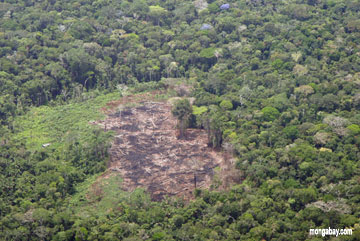Charcoal signatures: Heavily-populated Amazon was decimated by old world disease
Charcoal signatures: Heavily-populated Amazon was decimated by old world disease
Jeremy Hance, mongabay.com
June 9, 2008
Ecologists and archaeologists agree that when Columbus struck the Americas in 1492 everything changed, but questions persist over the kind of world Columbus and his followers would soon transform. Recently the state of the pre-Columbian Amazon has been under increasing debate among scientists across numerous fields. In a lecture given at the ATBC conference (Association of Tropical Biology and Conservation) in Paramaribo, Suriname, Dr. Francis Mayle weighed in on the debate.
The traditional view regarding pre-Columbian Amazonia goes something like this: prior to 1492 the Amazon was a virgin, pristine wilderness with only small populations of human inhabitants who had little effect on the ecosystem in which they lived. However, new ideas regarding population density in the pre-Columbian world and recent archaeological discoveries have led some to see the pre-Columbian Amazon very differently: more ‘cultural parkland’ (a term coined by Michael J. Heckenberger) than virgin wilderness. In this theory, a heavily-populated Amazonia held complex and sedentary societies which greatly affected their environment, so much so that the pre-Columbian Amazon may have been as much a product of human maintenance as environmental factors.
 Still burning the Amazon for agriculture – photo by Rhett A. Butler. |
In his talk Francis Mayle tested the validity of the ‘cultural parkland’ claim by employing data on charcoal in the Amazon. The presence of charcoal gives scientists an idea of how much burning occurred during various time periods. Since it is a well-accepted belief that high incidences of fire in the tropics are usually human-caused, more charcoal would mean a greater human-affect on the environment and vice-versa.
Using data from the Global Charcoal Database Mayles found what he was looking for: during the 16th Century–just after European arrival to the region–there was a sharp decrease of charcoal in the Amazon. The drop was so significant that it represents the nadir of charcoal presence in the Amazon over the last two-thousand years. Mayles described this finding as being in-step with the theory that when the Europeans came to the Amazon most of the native population was devastated by Old World diseases resulting in catastrophic population loss and thereby lessening the use of fire to control the environment. These findings are consitent with a study earlier this year by Mark Bush that also analyzed charcoal in Amazonian soil for evidence of fire and therefore human populations.
According to Mayles’ study the decline in charcoal begins in 1350 AD, over a century before Europeans disturbed the Amazon. This earlier date may hint that parts of the pre-Columbian civilization was already waning prior to European invasion. Mayles also expanded his research to the presence of charcoal in Western and Eastern North America, and found very similar results, including the lowest rates of charcoal just after European arrival, giving credence to the theory that both North and South American populations were ravaged by disease. In both continents, the remains of charcoal would not rise again until the 1800s. Mayles believes this to be consistent with the beginning of the Industrial Revolution.
Mayles is careful not to push his findings, stating that the data is “consistent with the ‘cultural parkland’ hypothesis but does not prove it”. Summing up, he told the many ecologists in the room that while they should “take care” when assuming an Amazonian plot is untouched by humans, he thought that the reality probably lay “somewhere in-between perfect virgin rainforest and the anthropogenic landscape that archaeologists would have you believe.”
Related
Ancient Amazon fires linked to human populations February 20, 2008
Analysis of soil charcoal in South America confirms that from a historical perspective, fire is rare in the Amazon rainforest, but when it does occur, it appears linked to human activities.
The Virgin Forest? Amazon Myths and New Revelations October 18, 2005
Controversial evidence uncovered over the past decade suggests that the Amazon rainforest was once home to large sedentary populations of people. Besides the well-known empires of the Inca and their predecessors, the Huari, millions of people once lived in the forests and shaped the environment to suit their own needs.







